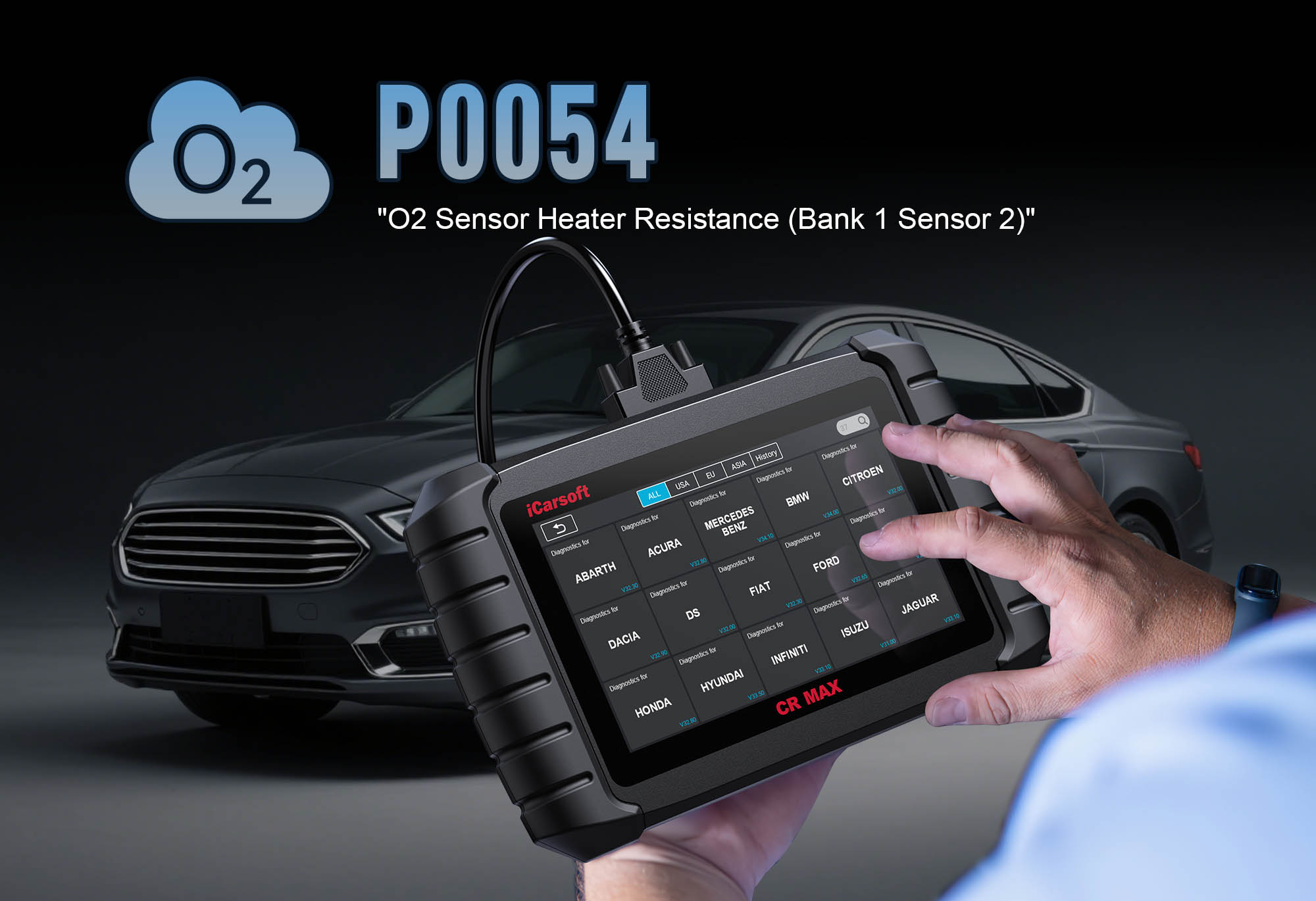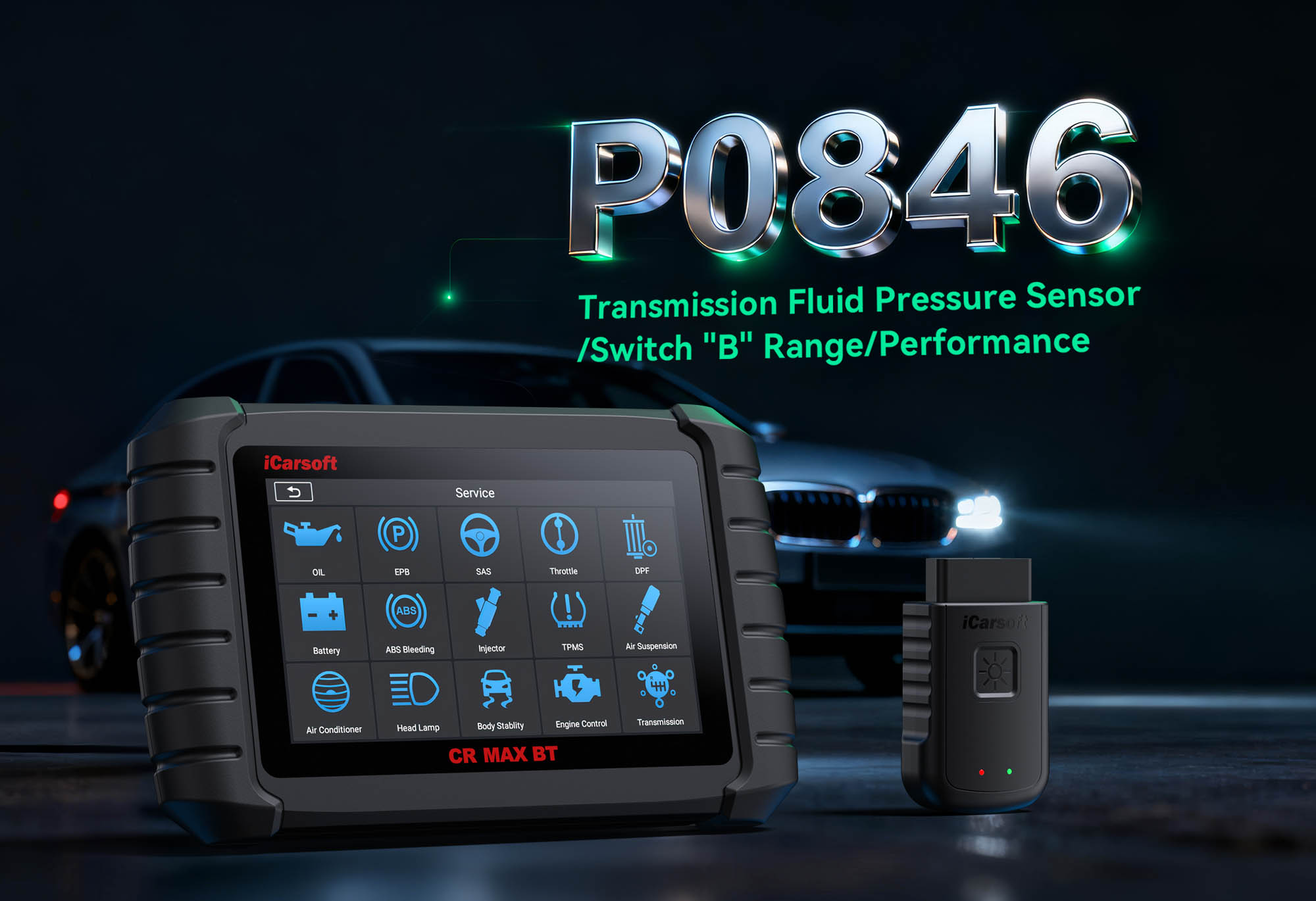Diagnose & Clear P0054 with iCarsoft CR MAX: Fix Oxygen Sensor Heater Issues
If your check engine light illuminates and a scan returns P0054, your vehicle is signaling a problem with its oxygen sensor heater circuit. This generic OBD-II code indicates "HO2S Heater Control Circuit Low (Bank 2, Sensor 1)"—meaning the Engine Control Module (ECM) is detecting abnormally low voltage in the heater circuit of the upstream oxygen sensor on Bank 2.
Oxygen sensors monitor exhaust gas composition to help the ECM adjust air-fuel mixture, and their internal heaters ensure they reach operating temperature (600–800°F) quickly—critical for accurate readings, especially during cold starts. When the heater circuit fails, the sensor takes longer to warm up, leading to delayed feedback, poor fuel economy, and increased emissions.
Basic scanners might only flag "oxygen sensor heater fault" but can’t distinguish between a faulty sensor, damaged wiring, or a blown fuse. The iCarsoft CR MAX solves this with advanced sensor circuit testing, real-time heater voltage monitoring, and vehicle-specific wiring diagrams. Let’s walk through how to use it to diagnose and resolve P0054.
Why It Matters
Ignoring P0054 goes beyond a lit check engine light—it harms your vehicle’s efficiency, performance, and environmental compliance. The oxygen sensor’s heater is critical for fast warm-up: without it, the sensor may take 5–10 minutes (instead of 30–60 seconds) to reach operating temperature. During this delay, the ECM relies on pre-programmed "open-loop" fuel maps, which often run richer than necessary—boosting fuel consumption by up to 10–15%.
Long-term neglect also increases emissions of hydrocarbons (HC) and carbon monoxide (CO), risking failure of state emissions tests. In severe cases, a non-functional heater circuit can cause hesitation during acceleration (as the ECM lacks real-time exhaust data) and even trigger secondary codes (e.g., P0150 for Bank 2 Sensor 1 circuit issues). Addressing P0054 early with the iCarsoft CR MAX prevents these cascading problems and avoids unnecessary sensor replacements.
Understanding P0054: Causes & Key Symptoms
To diagnose P0054 effectively, first break down the oxygen sensor heater system and its failure triggers:
Key Symptoms of P0054
-
Illuminated Check Engine Light: The primary indicator—activates when the ECM detects heater circuit voltage below 0.5V for 5+ consecutive seconds.
-
Poor Fuel Economy: Delayed sensor readiness forces the ECM to run a rich fuel map longer, increasing fuel consumption.
-
Cold Start Issues: Extended warm-up time leads to rough idle or stalling until the sensor heats up passively via exhaust heat.
-
Emission Test Failures: Incomplete combustion from incorrect air-fuel mixture raises HC and CO levels, violating emissions standards.
-
Reduced Performance: Hesitation during acceleration as the ECM struggles to optimize fuel delivery without real-time sensor data.
Common Causes of P0054
|
Cause
|
Description
|
|
Faulty Oxygen Sensor
|
Internal heater element burnout (most common cause)—sensor can’t generate heat to reach operating temperature.
|
|
Wiring Issues
|
Frayed wires, corrosion in connectors, or broken ground paths disrupt voltage flow to the sensor’s heater circuit.
|
|
Blown Fuse
|
A tripped "O2 Sensor Heater" or "HO2S" fuse (typically 10–15A) cuts power to the heater circuit entirely.
|
|
ECM Problems
|
Rarely, the ECM’s heater driver circuit fails to supply power—requires professional diagnostics to confirm.
|
|
Damaged Connector
|
Loose pins, water intrusion, or corrosion in the sensor’s electrical connector blocks voltage transmission.
|
Why iCarsoft CR MAX Excels at Diagnosing P0054
Basic OBD-II scanners only flag P0054 as a "heater circuit fault" without actionable details, but the iCarsoft CR MAX is designed to isolate the root cause with oxygen sensor-specific tools:
Heater Circuit Testing
Runs automated checks for voltage, resistance, and continuity in the Bank 2, Sensor 1 heater circuit—distinguishes between wiring issues and sensor failure.
Real-Time Voltage Monitoring
Displays live heater circuit voltage (normal range: 10–14V) to confirm if power reaches the sensor—catches intermittent voltage drops basic tools miss.
Sensor Activation Tests
Manually activates the oxygen sensor heater to measure current draw (typically 0.5–1.5A) and verify operational health.
Vehicle-Specific Data
Preloaded with Bank 2, Sensor 1 locations, fuse positions, and wiring diagrams for makes like Honda, Chevrolet, and Mercedes-Benz.
Component Location Guides
Shows exact placement of the upstream oxygen sensor (Bank 2, Sensor 1) – typically near the engine, upstream of the catalytic converter.
Auto VIN Detection
Automatically identifies engine configuration (V6, V8, etc.) to correctly map Bank 2—eliminates guesswork about cylinder bank placement.
Step-by-Step: Diagnose P0054 with iCarsoft CR MAX
-
1. Connect & Confirm the Code
Plug the CR MAX into your vehicle’s OBD-II port (under the dashboard) and power it on. Select your vehicle via Auto VIN (fast and accurate) or manual entry (make/model/year). Navigate to Engine > Fault Codes > Read Codes to confirm P0054. Tap Code Details for vehicle-specific insights (e.g., "Honda: HO2S Heater Voltage <0.3V at 2000 RPM" or "Chevrolet: Bank 2 Sensor 1 Heater Circuit Open").
-
2. Check for Related Codes
P0054 often pairs with other oxygen sensor issues that share root causes (e.g., blown fuses). Scan for complementary codes:
- P0030/P0036: Bank 1 Oxygen Sensor Heater Faults
- P0130-P0135: Bank 1, Sensor 1 Circuit Issues
- P0150-P0155: Bank 2, Sensor 1 Circuit Issues
Address these first—multiple codes likely indicate a shared problem (e.g., blown fuse) rather than isolated sensor failure.
-
3. Locate Bank 2, Sensor 1 Oxygen Sensor
Use the CR MAX’s Component Location tool to identify Bank 2 (varies by engine: for V6/V8, Bank 2 is typically the side without cylinder #1). Locate Sensor 1 (upstream of the catalytic converter, closest to the engine) using the tool’s interactive diagrams. Safely raise the vehicle with a jack (follow the CR MAX’s Safety Guidelines for jack point placement) if the sensor is under the vehicle.
-
4. Inspect the Sensor and Wiring
Visually examine the oxygen sensor and its harness for physical damage:
- Sensor Body: Look for oil contamination (sign of engine oil leak), carbon buildup, or cracks in the housing.
- Wiring Harness: Check for frayed insulation, cuts, or damage where the harness touches hot exhaust components (e.g., manifolds).
- Electrical Connector: Inspect for green/white corrosion, bent pins, or water intrusion—clean corroded connectors with electrical contact cleaner.
-
5. Test the Heater Circuit
Use the CR MAX’s specialized tests to isolate wiring vs. sensor issues: Navigate to Special Functions > Engine > Oxygen Sensor Tests > Heater Circuit Test. Select "Bank 2, Sensor 1" and run three key checks:
- Power Supply Check: Verifies 12V reaches the sensor’s heater circuit (failed = check fuse or wiring).
- Ground Test: Ensures proper ground connection (resistance <0.5Ω—high resistance = corroded ground).
- Heater Resistance Test: Measures heater element resistance (normal range: 5–15Ω for most sensors—open circuit = faulty sensor).
Save results to the CR MAX’s Notes for reference.
-
6. Check the Oxygen Sensor Fuse
Use the CR MAX’s Fuse Diagram tool to locate the "Oxygen Sensor Heater" or "HO2S" fuse (typically 10–15A, found in the engine bay or interior fuse box). Remove the fuse and inspect for breaks or blackening—replace with a fuse of the same amperage if blown. If the new fuse blows immediately, there’s a short circuit in the heater circuit (check for damaged wiring touching metal components).
-
7. Perform Sensor Swap Test (If Possible)
If your vehicle has identical upstream sensors (Bank 1, Sensor 1 and Bank 2, Sensor 1), swap them using the CR MAX’s Component Diagram for guidance. Rescan after swapping:
- P0054 moves to P0030 (Bank 1, Sensor 1 Heater Fault) = faulty Bank 2 sensor (needs replacement).
- P0054 remains = wiring, fuse, or ECM issue (return to Step 5 to re-test circuit).
-
8. Repair & Clear P0054
Fix the root cause based on diagnostics:
- Faulty Sensor: Use the CR MAX’s Part Lookup to find compatible OEM sensors (e.g., Denso 234-4629) and follow installation guides.
- Wiring Issues: Splice frayed sections with heat-shrink connectors; replace severely damaged harnesses.
- Corroded Connectors: Clean with contact cleaner and apply dielectric grease to prevent future corrosion.
- Short Circuits: Insulate exposed wires to stop contact with metal.
Clear the code: Navigate to Engine > Fault Codes > Clear Codes to delete P0054.
-
9. Verify the Repair
Take a 15–20 minute test drive, including a cold start to monitor sensor warm-up. Use the CR MAX’s Data Logging to record "Oxygen Sensor Heater Voltage"—should read 10–14V when the heater is active. Re-scan after the drive: No return of P0054 + stable heater voltage = successful repair; code returns = revisit circuit testing or consult a professional for ECM diagnostics.
Preventing P0054 Recurrence
Use the iCarsoft CR MAX to maintain healthy oxygen sensor performance and avoid future heater circuit issues:
-
Quarterly Sensor Checks: Run Special Functions > Engine > Oxygen Sensor Health Scan to test heater resistance and circuit integrity.
-
Wiring Inspections: Check sensor harnesses during oil changes—ensure they’re secured away from hot exhaust components and moving parts.
-
Fuse Checks: Test the O2 sensor heater fuse annually (use the CR MAX’s fuse map to locate it) to catch weak fuses before they blow.
-
Connector Maintenance: Apply dielectric grease to sensor connectors after repairs to repel water and prevent corrosion.
-
Fuel System Care: Use quality fuel and periodic fuel system cleaner to prevent carbon buildup or oil contamination on the sensor.
Summary Table
|
Step
|
Action
|
|
1
|
Connect CR MAX, confirm P0054, and review vehicle-specific code details
|
|
2
|
Scan for related oxygen sensor codes to identify shared issues
|
|
3
|
Locate Bank 2, Sensor 1 using Component Location tool
|
|
4
|
Inspect sensor body, wiring harness, and electrical connector
|
|
5
|
Run heater circuit tests (power, ground, resistance)
|
|
6
|
Check and replace O2 sensor heater fuse if blown
|
|
7
|
Perform sensor swap test (if applicable) to confirm sensor health
|
|
8
|
Repair root cause (sensor/wiring/fuse) and clear P0054
|
|
9
|
Test drive, log heater voltage, and re-scan to verify repair
|
Conclusion
P0054’s "heater circuit low" label can be misleading—what seems like a sensor issue might actually be a simple blown fuse or corroded wire. The iCarsoft CR MAX eliminates guesswork with specialized oxygen sensor tools, real-time monitoring, and vehicle-specific data, ensuring you fix the root cause (not just the code).
Whether you’re replacing a faulty sensor, repairing wiring, or swapping a fuse, the CR MAX guides you through every step—saving time and avoiding unnecessary parts costs. By addressing P0054 promptly, you’ll restore fuel efficiency, pass emissions tests, and keep your vehicle running smoothly for longer.
FAQs About P0054 Code
Q: Can I drive my vehicle with P0054?
A: Short-distance driving (e.g., to a repair shop) is usually safe, but avoid long trips. The delayed sensor warm-up will reduce fuel economy and may cause rough idle. If you notice hesitation or stalling, stop driving and diagnose with the CR MAX immediately—these signs indicate a more severe circuit issue.
Q: Will replacing the oxygen sensor always fix P0054?
A: No—only if the sensor’s internal heater is faulty. The CR MAX’s heater resistance test confirms this: if resistance is outside 5–15Ω, the sensor needs replacement. If resistance is normal, the issue is wiring, a fuse, or ECM—replacing the sensor will waste money.
Q: How do I find Bank 2 on my vehicle?
A: Use the CR MAX’s Auto VIN Detection and Component Location tools—they automatically map Bank 2 based on your engine. As a general rule: for V-shaped engines (V6/V8), Bank 2 is the cylinder bank without cylinder #1; for inline engines (I4/I6), Bank 2 only exists if there are two separate exhaust systems (rare).
Q: How much does it cost to fix P0054?
A: Costs vary by cause: Fuse replacement = $5–$20; Wiring repair = $100–$300 (professional); Oxygen sensor replacement = $150–$400 (OEM part + labor); ECM repair = $500–$1,200 (rare). The CR MAX helps avoid expensive fixes by identifying low-cost issues (e.g., fuses) first.





